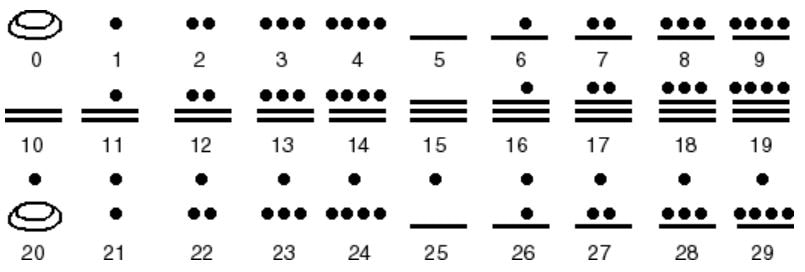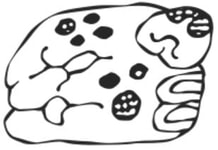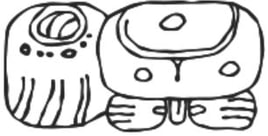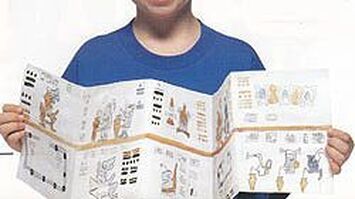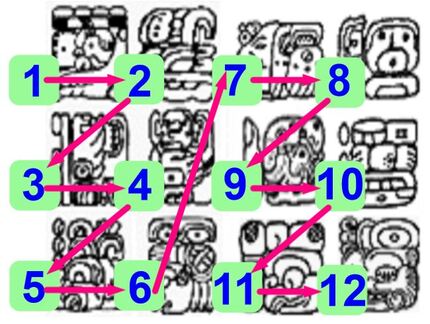Maya Writing Activity
Code Read
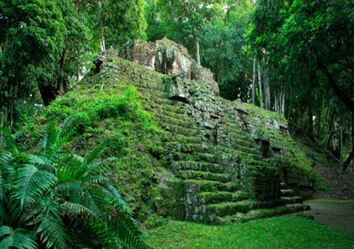
Imagine explorers arriving in the future to find all of our cities deserted, with all of the people having disappeared. Now imagine that along with the people all of our books also disappeared, having perished in some unknown catastrophe. All that is left to speak for us are the written words we carved in stone. The travelers can't make sense of our mysterious script, but if they could, what would our writing tell them about who we were?
In the jungles of southern Mexico and Central America, the ancient ruins of the Maya presented just such a mystery when archaeologists first began to unearth the remains of Maya cities in the late 19th century. At that time, the scientists discovered that the magnificent cities the Maya left behind revealed a civilization of astonishing achievements. The Maya cities that they found were full of strange inscriptions that were carved on monuments and objects, painted on pottery, and written in bark-paper books.
In the jungles of southern Mexico and Central America, the ancient ruins of the Maya presented just such a mystery when archaeologists first began to unearth the remains of Maya cities in the late 19th century. At that time, the scientists discovered that the magnificent cities the Maya left behind revealed a civilization of astonishing achievements. The Maya cities that they found were full of strange inscriptions that were carved on monuments and objects, painted on pottery, and written in bark-paper books.
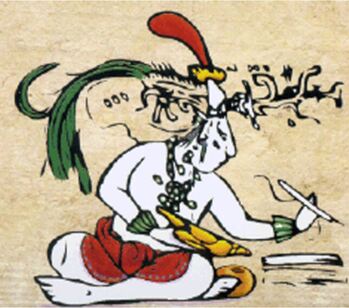
These days, almost every child goes to school to learn how to read and write. If you go back in time, however, not every child learned to read and write. Those things were left up to specialists called scribes. Over time, it is not only who could write that changed, but how they wrote.
It wasn’t that long ago that all you needed was a pencil and a piece of paper to make a list, write a thank you note to your grandma, keep a journal, or tell a story. Further back, writers scratched letters into wet clay or wax tablets, or they carved them into stone. Now, of course, no pencil or paper is even required. Kids text on phones and type on tablets and, using programs that convert speech to text, speak into a microphone. No matter how it’s been done through the ages, recording information has always been important, and it will forever remain so. Without the ability to read and write, our relationships, our understanding of the world around us, and our joy in discovering new worlds through the books we read would all suffer.
It wasn’t that long ago that all you needed was a pencil and a piece of paper to make a list, write a thank you note to your grandma, keep a journal, or tell a story. Further back, writers scratched letters into wet clay or wax tablets, or they carved them into stone. Now, of course, no pencil or paper is even required. Kids text on phones and type on tablets and, using programs that convert speech to text, speak into a microphone. No matter how it’s been done through the ages, recording information has always been important, and it will forever remain so. Without the ability to read and write, our relationships, our understanding of the world around us, and our joy in discovering new worlds through the books we read would all suffer.
|
|
For the Maya, of course, writing was never as easy as we find it today. The ancient Maya didn't have any mass-produced paper or pencils or books, and not all children were taught how to write. Individuals who belonged to the nobility, the elite of the Maya empire, were the only ones who were allowed to write. When Maya priests or kings wanted to commemorate an event, they requested specially appointed scribes to record it. And that is how part of Maya history was preserved.
|
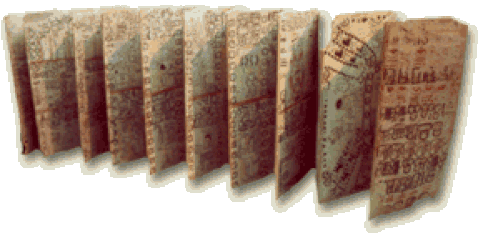
Much of what remains of the history recorded by the Maya exists because it was carved in stone. While the work carved in stone has been invaluable, the most common place for Maya writing was probably the highly perishable bark-paper books they created. Unfortunately, not many of those have survived the hot, humid conditions of the rainforest.
How did the Maya write?
The ancient Maya didn't have a pencil or ink, and there weren’t any worksheets to complete for their teacher. All that they would use to write is what they found in their natural surrounding. They made their ink out of natural pigments and they wrote with paintbrushes or with quill pens made from the feathers of wild turkeys. The paper they used was made from the bark of fig trees. To make a fresh, white writing surface, they bleached their bark-paper with lime. They folded the paper into long strips and bound them with wood and deer-hide to make a type of book called a codex. Today, you will create your own codex but, first, let's find out a bit more about how the Maya wrote.
The Mayas did not use letters to write but, instead, used drawings. Their drawings are known as hieroglyphs, or just glyphs. Sometimes, we also use drawings instead of written words. Look at the pictures below and see if you know what each means.
How did the Maya write?
The ancient Maya didn't have a pencil or ink, and there weren’t any worksheets to complete for their teacher. All that they would use to write is what they found in their natural surrounding. They made their ink out of natural pigments and they wrote with paintbrushes or with quill pens made from the feathers of wild turkeys. The paper they used was made from the bark of fig trees. To make a fresh, white writing surface, they bleached their bark-paper with lime. They folded the paper into long strips and bound them with wood and deer-hide to make a type of book called a codex. Today, you will create your own codex but, first, let's find out a bit more about how the Maya wrote.
The Mayas did not use letters to write but, instead, used drawings. Their drawings are known as hieroglyphs, or just glyphs. Sometimes, we also use drawings instead of written words. Look at the pictures below and see if you know what each means.
From left to right, $ is a common symbol that represents money; An arrow indicates direction; The next symbol indicates either an item is recyclable or recyclable objects are accepted there; A skull with bones represents danger. We sometimes see it on poisonous contents and it is also a symbol that people who do not know how to read can understand.
The Maya writing system is a logosyllabic writing system. That means that it combines signs or symbols (glyphs) representing sounds and syllables with glyphs representing entire words. While English uses 26 letters, 10 numerals, and various marks of punctuation, Maya writing is much more expansive. At any one time, there were 500-800 glyphs, or signs, in use. Of those, 200 glyphs represented sounds or syllables, giving the ancient Maya a terrifically complex but highly expressive system of writing.
The Maya writing system is a logosyllabic writing system. That means that it combines signs or symbols (glyphs) representing sounds and syllables with glyphs representing entire words. While English uses 26 letters, 10 numerals, and various marks of punctuation, Maya writing is much more expansive. At any one time, there were 500-800 glyphs, or signs, in use. Of those, 200 glyphs represented sounds or syllables, giving the ancient Maya a terrifically complex but highly expressive system of writing.
- When done, exchange your codex with a friend. Translate their story while they translate yours.
- And, most importantly, have fun!



